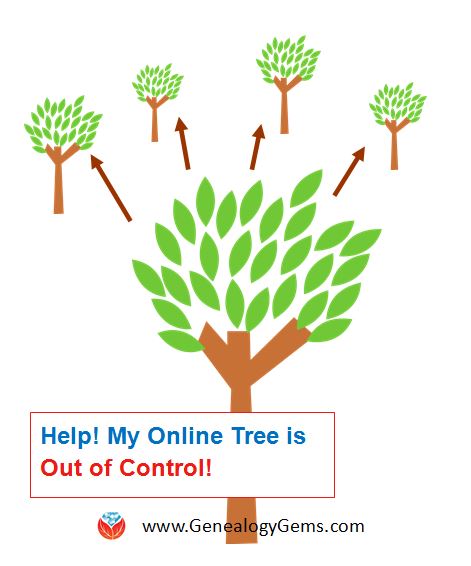Is someone else’s Ancestry family tree causing a pain in your own tree trunk? Here’s a way to approach it–nicely!
Scott is a new Genealogy Gems listener and he recently dropped me a line about a problem that just a few–ok, nearly every–genealogist has at some point come face-to-face with: an error on an Ancestry family tree. Scott writes:
“I recently found your podcast and have been listening with great interest. I really appreciate your experienced, informed, yet common sense approach to genealogy. Because of this common sense approach, I felt you would be a great source of advice for a dilemma I am having.”
This Genealogy Gems listener went on to describe coming across a family tree in the Ancestry forest that included his family line. It featured good research that mirrored his own and some additional that gave him hints that lead to even more branch extensions. “The only problem is, there is a critical error in her research: the starting point that she uses for that whole line is incorrect.”
Scott believes he has very good documentation and support for his claim. In fact he notes that she even has a document attached to her tree that supports his case that she has made an error.
“My dilemma: How do I appropriately connect with her to let her know that she has made an error? This individual has made a concerted effort to research and cite, and does it better than almost all the others on that line have done. I want to let her know so she can dedicate and direct those wonderful skills in the right direction, but I want to do it in a considerate way. Everyone makes mistakes of this nature – I sure have!! What is the best way to make an initial contact that exposes an error?”
If you participate in Ancestry’s online family trees then you have probably faced an Ancestry tree error. Let’s be honest: Genealogists can grow quite cynical about the intentions of others when they see so many trees lacking sources, and errors within trees. It’s frustrating to run into. Interestingly, in Scott’s description of his situation he’s already demonstrated the approach I would  recommend. Here’s what I told him:
recommend. Here’s what I told him:
- You’ve assumed the best (not the worst) about her approach to the research
- You want to help
- You know that everyone makes mistakes
I would weave that into the following approach that I like to take with any situation, genealogical or otherwise, where I need to approach someone about incorrect work:
1. Start with a compliment.
“I’m so impressed by all the work you have clearly accomplished so far….”
2. Address the problem by assuming that they are ultimately interested in accuracy.
“I wanted to make you aware of something I found which I believe changes the conclusions about this particular family line. I think you’ll find this as interesting as I did….” This approach, by the way, doesn’t say ‘I’m right, you’re wrong’ but rather it says the facts and data are right and you’re guessing they will be as interested in the facts as you are.
3. End with a sincere compliment or expression of appreciation
“Again, I’m so grateful that you have shared your tree online and I look forward to hearing from you”
And finally, when addressing an error on an Ancestry family tree, as with all things in life, we have to manage our expectations. If you don’t hear back, or get a negative response, just know that the other researcher may be emotionally invested in their findings in a way you’re not aware of, or may no longer be actively working on it, and not have time to revisit it right now. (For all we know, their spouse could have just gone into the hospital.)
Bottom line: An error on an Ancestry family tree is a pain in the tree trunk. Focus on placing your accurate tree online, fully cite your sources, and move on, knowing that you are offering other researchers who come across both trees an alternative.
 More Resources for Your Family Tree
More Resources for Your Family Tree
- Don’t Lose Control When You Post Your Family Tree Online
- Why Use Ancestry for FREE if You’re Not a Subscriber
Disclosure: This article contains affiliate links and Genealogy Gems will be compensated if you make a purchase after clicking on these links (at no additional cost to you). Thank you for supporting Genealogy Gems!

